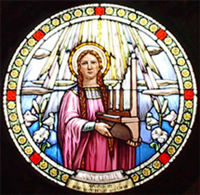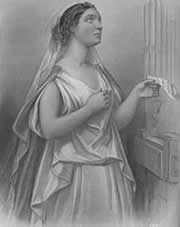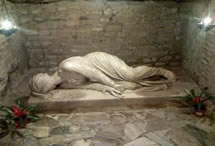
St Caecilia Stained Glass Window in the Church of Our Lady of Mount Carmel, in Bristol, Rhode Island, USA (Reprinted with permission)

St Caecilia Black and White Portrait

St Caecilia Crypt in Roman Catacombs
|
St. Caecilia was a patrician woman of second century Rome. Her life was, to put it mildly, harsh, and her martyrdom was, to put it, even more mildly, cruel. Her recorded life begins with her marriage, forced by her parents, against her will, to Valerian of Trastevere. She had planned to devote her life to serving God, and during her wedding feast, she remained alone in a corner, praying while the others ate and danced. The Acta of Cecilia includes the following: “While the profane music of her wedding was heard, Cecilia was singing in her heart a hymn of love for Jesus, her true spouse.” It was this phrase that led to her association with music, singers, musicians, etc. As a result she has become the patron saint of music. It should also be noted that the original meaning of the name Caecilia (original Latin form) or Cecilia means “blind”, therefore she is also patron saint of the blind.
Her husband was a remarkable man who agreed to respect her vow of virginity. Cecilia told her new husband that she was accompanied by an angel, but in order to see it, he must be purified. He and his brother Tibertius were both impressed by Caecilia's piety, and they too were soon baptized by Pope Urban. Together, the three led a life of buying the remains of Christian martyrs and giving them proper burials. Of course, as was the rule in Roman Rome, no good deed was ever left unpunished, and Valerian and Tibertius were quickly hauled before prefect Almachius's court. He ordered them to sacrifice to the pagan gods, and when they refused, he sentenced them to be scourged and beheaded. During their whippings, they even managed to convert one of their guards to Christianity, Maximus. He too died with them.
Caecilia of course rushed out to get their bodies, and lovingly buried them in the cemetery of Praetextatus. Having lost her husband, her brother-in-law, and the soldier who whipped them both, she re-decorated her home. Almachius was horrified to see the new scheme - a fetching church interior, complete with services, and attempted to force her to renounce her Christianity. Having no
more luck with her than with her husband, he sentenced her to death too. Her death sentence was to be carried out by suffocating her in her own bath. Locked in her bathroom, the executioners stoked the furnace until the temperature in the Roman bath was seven times the normal temperature. Several hours later, Caecilia emerged unharmed. The same could not be said for her new wallpaper, which was in tatters. Enraged, Almachius ordered her to be beheaded. Proving that a Ginsu knife is only as good as he who wields it, an incompetent soldier managed to only to fatally wound her after three attempts. Over the next three days, she lay in pain, singing songs of praise to God, and comforting herself with sacred music, as her friends came to seek her final blessings. Finally, she died, never once forsaking her faith in Christ. Pope Urban blessed her body three days later. The year of her martyrdom is recorded as being approximately 177AD, during the time of the emperor Alexander Severus .
Following Caecilia's death she was originally buried in the Catacombs of St Callixtus which are among the greatest and most important of Rome. They originated about the middle of the second century and are part of a cemeterial complex which occupies an area of 90 acres, with a network of galleries about 12 miles long, in four levels, more than twenty metres deep. In it were buried tens of martyrs, 16 popes and very many Christians.
The underground cemetery includes several areas. The Crypts of Lucina and the area of the Popes and of St Caecilia are the most ancient areas (2nd century). The other areas are named after St Miltiades (half of the 3rd century), St Gaius and St Eusebius (end of 3rd century), the Western Area (first half of the 4th century) and the Liberian Area (second half of 4th century).
As stated above, the tomb of St Caecilia adjoined the area of the Popes. In 817AD, her tomb was transferred from the above mentioned crypt and her body was removed to the Church of St Cecilia in Rome. There is a statue of St Caecilia where she was originally entombed. This statue is a copy of the celebrated work sculptured by Stefano Maderno in 1599, after her tomb, now at the church of St Cecilia, was opened and her body was found to be incorrupt. The original crypt, prior to the transfer of her tomb, was all covered with mosaics and paintings (beginning of the ninth century AD - 817AD). On the wall, near the statue, we see an ancient painting of St Caecilia in an attitude of prayer; lower down, in a small niche, is a fresco representing Christ holding a Gospel. On the right side is the figure of St Urban. On the wall of the shaft is the painting of three martyrs: Polycamus, Sebastian and Quirinus.
|

